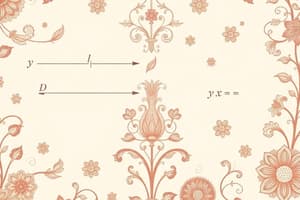Podcast
Questions and Answers
What is a characteristic of a linear equation?
What is a characteristic of a linear equation?
When a linear equation is graphed in two dimensions, how many points does the line pass through?
When a linear equation is graphed in two dimensions, how many points does the line pass through?
What is the main goal of solving linear equations?
What is the main goal of solving linear equations?
In the standard form of a linear equation, what do 'a', 'b', and 'c' represent?
In the standard form of a linear equation, what do 'a', 'b', and 'c' represent?
Signup and view all the answers
What is the significance of linear equations in fields like physics and economics?
What is the significance of linear equations in fields like physics and economics?
Signup and view all the answers
Which operation is involved in eliminating a variable when solving linear equations?
Which operation is involved in eliminating a variable when solving linear equations?
Signup and view all the answers
What is the most general form of a linear equation in two variables?
What is the most general form of a linear equation in two variables?
Signup and view all the answers
What are the constant coefficients in the standard form of a linear equation?
What are the constant coefficients in the standard form of a linear equation?
Signup and view all the answers
How do linear equations in standard form help in understanding the relationship between variables?
How do linear equations in standard form help in understanding the relationship between variables?
Signup and view all the answers
Why are linear equations, especially in standard form, widely used in various disciplines?
Why are linear equations, especially in standard form, widely used in various disciplines?
Signup and view all the answers
In the equation 4x + 3y = 9, what does the value of A represent?
In the equation 4x + 3y = 9, what does the value of A represent?
Signup and view all the answers
What is the primary purpose of isolating variables in linear equations?
What is the primary purpose of isolating variables in linear equations?
Signup and view all the answers
Study Notes
Linear Equations and Standard Form
Linear equations have been a fundamental part of mathematics since ancient times, dating back to Babylonians who used linear problems to solve practical issues like land value taxation. They are essential in fields such as physics and economics, where predicting trends and relationships between variables is crucial. In algebra and geometry, they serve as building blocks for more complex concepts. Let's delve into what makes these simple yet powerful mathematical tools tick.
What are Linear Equations?
A linear equation can be defined as any expression involving one variable with only first degree terms. For example, (x + 2y = 7) is a linear equation because it has two variables ((x) and (y)) and each term contains just one of them raised to the power of 1. A common representation of a linear equation in two dimensions is: [ax+by=c]where (a), (b), and (c) are constants and (x) and (y) represent points on a line. When graphed, this equation represents a straight line passing through three distinct points.
Solving Linear Equations
Solving linear equations means finding all possible values of their unknowns which make the expressions true. There are several methods to do so. One popular method involves eliminating a variable by adding, subtracting, multiplying, or dividing both sides of the equation until you get either zero, or an equivalent equation with different coefficients. Another approach uses substitution, replacing an occurrence of one symbol with another, usually based on known properties of equality. These techniques allow us to isolate variables which ultimately leads to solving linear equations.
Standard Form of a Linear Equation
The most general form of a linear equation in two variables is Ax + By = C, where A, B, and C are real numbers, with neither A nor B being equal to zero. This format is often referred to as the 'Standard Form' of a linear equation. In summary, the Standard Form helps identify and analyze key components within a given linear equation - namely, the constant coefficients (A and B) and the right hand side (C). It provides a clear structure for understanding the relationship between the independent and dependent variables in the equation.
For instance, consider the following linear equation in standard form: [ 4x+3y=9 ]Here, A = 4, B = 3, and C = 9. To solve this equation, we would typically manipulate the equation using basic operations to eliminate one variable, leaving behind a single equation after substituting its solution into the other variable.
In conclusion, linear equations, particularly those expressed in standard form, are ubiquitous across numerous disciplines due to their simplicity yet profound applicability. Their utility ranges from calculating areas of rectangles to analyzing data sets and solving complex systems of equations. Whether encountered during everyday life or applied in advanced math courses, grasping the concept of linear equations is indeed a cornerstone of quantitative reasoning
Studying That Suits You
Use AI to generate personalized quizzes and flashcards to suit your learning preferences.
Description
Explore the fundamentals of linear equations and their standard form, crucial in algebra, geometry, physics, and economics. Learn to solve linear equations by isolating variables and grasp the significance of the standard form in identifying relationships between independent and dependent variables.




